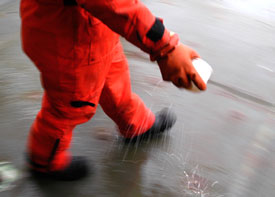 |
Daily Update
Calendar
Dispatch 37 - October 16, 2003
By C. A. Linder
Weather conditions: Overcast skies, 25 kt winds, 5-7 ft seas,
air temperature 30°F
 |
 |
| Boatswain's Mate
Scott Lussier scatters salt on deck to break up the ice. |
| Click
to enlarge |
Three Hundred and Twenty One
At 7:58 PM, we brought the CTD on deck for the 321st and final time
on this cruise. We were all wearing smiles of happiness and relief.
After five solid weeks of mooring and CTD work, it was an incredible
feeling of satisfaction to finally be done. The science party cheered
as Marine Science Technician Bridget Cullers cut the cable to the
CTD. The bridge crew pointed Healy's nose to the south
and gunned the engines. Nome here we come.
Students from Mrs. Lyons' 5th grade
class at Mt. Alvernia Academy in Chestnut Hill, Massachusetts
have this question about ice and global warming.
Question from Mary Aiden and Marcello: Since the Arctic is a big block of ice, if the warm water came into the Arctic Ocean would it melt it? Is there any way to stop Global Warming?
Chief Scientist Rebecca Woodgate answers this question:
"Dear Mary and Marcello,
Basically yes, as warm water comes into the Arctic Ocean it melts the ice, if it comes in at the surface. You can see that in the ice melt back patterns here in the Chukchi. We talk about three main flows of water north through the Chukchi (one through Barrow Canyon, one through Herald Valley and one through the Central Channel) and you see these three tongues melting their way into the Arctic as the ice edge goes back in spring/summer.
There are three main inflows into the Arctic. One is here, from the Bering Strait and Chukchi Sea. The others are over on the European side. One is through Fram Strait (between Greenland and Spitzbergen) and the other is from the Barents Sea (the large shelf sea east of Spitzbergen). These last two bring warm Atlantic water into the Arctic. That too melts the ice while it is at the surface. Again you can see it in how the ice melts back in spring. The Atlantic water carries on throughout the Arctic Ocean, but its effect on the ice is much less as the warm Atlantic water is covered by a layer of cold water which acts like a blanket to keep the warmth of the Atlantic water away from the ice. We call this layer the Cold Halocline (cold obviously as it is cold, and halocline as it is a layer in which the salinity (halo) increases (cline - think of incline)). It comes from the shelf seas of the Arctic and from waters that flow into the Arctic from the Pacific in winter.
We've seen an increase in the temperature of the Atlantic water coming into the Arctic since the 1990s. We've seen a thinning of the sea-ice in the Arctic ocean over some decades. Are they related? - hard to say.
By the way, the Arctic sea-ice is not one large sheet of ice like
Antarctica. It's a huge number of floating pieces of ice (floes).
Bits can be as small as the floor-area of your classroom, to the
size of your school and all the playing fields, to even bigger.
They float around, driven by the wind and the ocean currents and
tides, bumping up against each other and crushing their edges into
ridges that can be 20 ft high (and 4 or more times that deep), coming
apart and leaving strips of open water (leads), which rapidly freeze
over (if it's cold enough, which it is mostly, especially in winter),
forming new bits of ice. You can spend a lifetime studying this
stuff!
Your second question - is there any way to stop Global Warming?
That's a billion dollar question alright. A lot of people spend
a lot of time looking into this, and no-one has an easy answer yet.
If it's due to the way we are polluting the planet, and a lot of
evidence points that way, then by taking positive steps to limit
greenhouse emissions e.g. by conserving energy or using renewable
energy sources (e.g. solar, wind and wave energy) we can hope to
mitigate the problem. Given we don't really know at the minute,
it's probably best to do whatever we can, in case in 10 years we
look back and realize we could have done something, and we didn't."
With our science operations finally completed, it's full speed ahead
southwards to Nome. It will be a hectic couple of days packing and
cleaning in the lab. We need to box up computers, make CDROMs of our
data, and sweep the floors. After five weeks of living in relative
isolation on the wide open sea, it's time to start thinking
about the outside world again. It's going to be strange seeing houses,
cars, flowers, and trees again, but we can't wait.
 Previous
Dispatch
Next Dispatch Previous
Dispatch
Next Dispatch

Back to
Calendar
|




